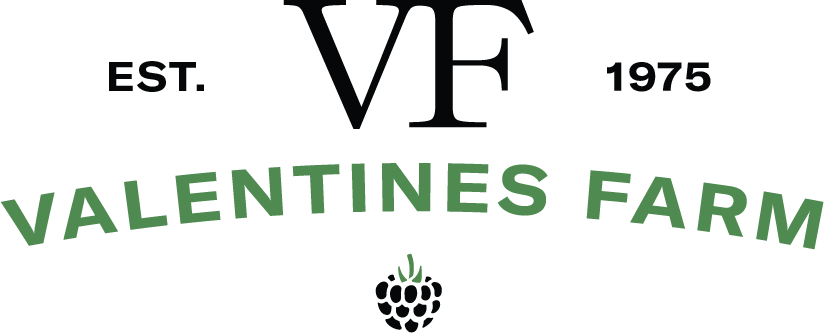Buzzzzing With Activity
Have you heard the buzz? Last week, Valentines Farm welcomed five new colonies of honeybees to our on-site apiary!
The science (and art!) of beekeeping (or apiculture) has a long and rich history throughout the world, dating back to about 7,000 BC in Northern Africa, where people were keeping bees in pottery vessels. A few thousand years later, Ancient Egyptians had already begun to develop a system using smoke, simple hive structures, and honey collection.
Fast-forward another few thousand years, and here at Valentines Farm we are trying our hand at two different methods of beekeeping: biodynamic and organic. Our resident Farmer Francisco is excited to be in his second season of beekeeping and is currently furthering his knowledge with Spikenard Farm’s online biodynamic beekeeping course. This season, he’ll be maintaining two hives using biodynamic principles. Our friends at Backyard Bees also keep four hives here at VF using organic practices.
What’s the distinction between biodynamic and organic beekeeping, you ask? Though there are many specific differentiating factors, the key thematic difference lies in the end goal. Organic beekeeping focuses on boosting honey production, while caring for bee health by refusing to use harmful chemicals in the process. Biodynamic beekeeping, on the other hand, focuses solely on strengthening bee health and encouraging bees to develop in line with their truest nature - honey for human consumption is seen as only an added benefit!
Here at VF, we recognize that the bee colony transport and transition processes are very delicate and can be challenging. With that in mind, we knew we first had to ensure that our space was adequately prepared for the arrival of our new buzzy friends. This involved carefully assembling the hives, inspecting each of them to be sure they were ready for their new inhabitants. We also took the time to brew Spikenard Farm’s special “bee tea” made with honey and steeped medicinal herbs (chamomile, nettle, yarrow, etc.) and supplied it to the bees via a feeder. This concoction provides the bees with the metabolic jumpstart they need to hit the ground running in constructing their wax combs. Combs are the true foundation of good beekeeping, as these structures are where bees will store their future honey, where the queen will lay her eggs, and where the nurse bees will care for her young.
Once the tea was prepped, it was time to pick up the new colonies. Last Saturday afternoon, Farmer Francisco hopped into our farm truck and drove out to Queens to pick-up the farm’s newest residents. After a careful drive back and donning some bee suits, the VF crew and Backyard Bees were ready to move the bees into their new homes.
The first step in the transfer process is to create a cold smoke near the hive with a smoker (see below) which keeps the bees calm during a bound-to-be-stressful time. Next, we carefully unlatch the bee’s plastic transit containers and shake them into the hives, without causing too much disturbance. As commercial bees are not raised as a unified colony, the queen bee is initially kept in a separate “cage” to allow the rest of the bees to bond with and imprint on her over time, until they finally come to recognize her as their queen. The success of this process is crucial, as bees’ response to the queen’s pheromones is what creates “hive mind”, allowing for a healthy and thriving colony.
After transitioning the masses to the hive, we gently uncorked the “cage”, placing the queen into her new palace. This step is key, as all other bees will follow the queen, so securing her in the hive is of the upmost importance.
From there, we breathed a quick sigh of release, then promptly went to work closing up the hives to gather the bees in a warm, unified cluster. The inside of the hive should ideally be dark and at a balmy 95℉, prolonged exposure to the elements can cause bees some serious stress! We then took care to gently brush off some stragglers hanging out on the edges of the hive so they didn’t get squished, ensuring they found their way back inside through the small front door!
After a few more rounds of checks and double-checks, we felt assured that all our bees were happy in their new homes.
Four days later, we opened up the hives again briefly to check in on comb construction. Each hive was abuzz with activity, with busy bees at work building their precious combs. While most were perfectly aligned, one comb had been constructed askew, so we carefully used a tool to correct it. As bees work off of previously-built comb as a template, implementing this “correcting” technique early on ensures the bees will continue to construct their combs in a straight vertical form.
As of now, our bees are buzzing away, enjoying their homemade tea and even starting to collect nectar from some of spring’s first blooms. Here’s hoping that the rest of the season will be just as sweet!






